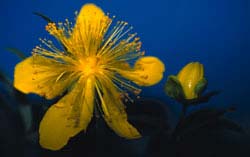Flower Chemicals Both Attract Friends and Deter Foes

Talk about multi-tasking. A new study reveals that in the St. John’s Wort plant, Hypericum calycinum, the same chemical not only attracts pollinating insects but also deters herbivores that pose a threat to its survival. The findings appear in the current issue of the Proceedings of the National Academy of Sciences.
To the human eye, the flowers of H. calycinum appear as uniform yellow disks (top image). Insects with ultraviolet-sensitive eyes, however, see a dark, ultraviolet-absorbing center (bottom image), which acts as a bull’s-eye to help the insects narrow in on the nectar. According to the new research, one class of pigments responsible for this UV pattern is dearomatized isoprenylated phloroglucinols, or DIPs. The investigators also found high concentrations of DIPs on the plant’s reproductive structures, which suggest that the chemicals serve additional purposes in the plant. “Just as important as attracting pollinators to a plant is producing a viable seed,” team member Matthew Gronquist of Cornell University explains, “so there is an evolutionary incentive to protect the reproductive apparatus from herbivores.”
Indeed, the scientists found that hypercalin A, one of the DIPs isolated from H. calycinum, deterred larvae of the rattlebox moth. Those caterpillars unlucky enough to ingest the hypercalin A died. The researchers conclude that DIPs act simultaneously to draw pollinators and discourage predators. “Now that we know where to look,” study co-author Thomas Eisner remarks, “antifeedant chemicals like the DIPs undoubtedly will be found in other plant species, and they offer clues to more natural insect control agents.”
Media Contact
All latest news from the category: Life Sciences and Chemistry
Articles and reports from the Life Sciences and chemistry area deal with applied and basic research into modern biology, chemistry and human medicine.
Valuable information can be found on a range of life sciences fields including bacteriology, biochemistry, bionics, bioinformatics, biophysics, biotechnology, genetics, geobotany, human biology, marine biology, microbiology, molecular biology, cellular biology, zoology, bioinorganic chemistry, microchemistry and environmental chemistry.
Newest articles

Superradiant atoms could push the boundaries of how precisely time can be measured
Superradiant atoms can help us measure time more precisely than ever. In a new study, researchers from the University of Copenhagen present a new method for measuring the time interval,…

Ion thermoelectric conversion devices for near room temperature
The electrode sheet of the thermoelectric device consists of ionic hydrogel, which is sandwiched between the electrodes to form, and the Prussian blue on the electrode undergoes a redox reaction…

Zap Energy achieves 37-million-degree temperatures in a compact device
New publication reports record electron temperatures for a small-scale, sheared-flow-stabilized Z-pinch fusion device. In the nine decades since humans first produced fusion reactions, only a few fusion technologies have demonstrated…





















